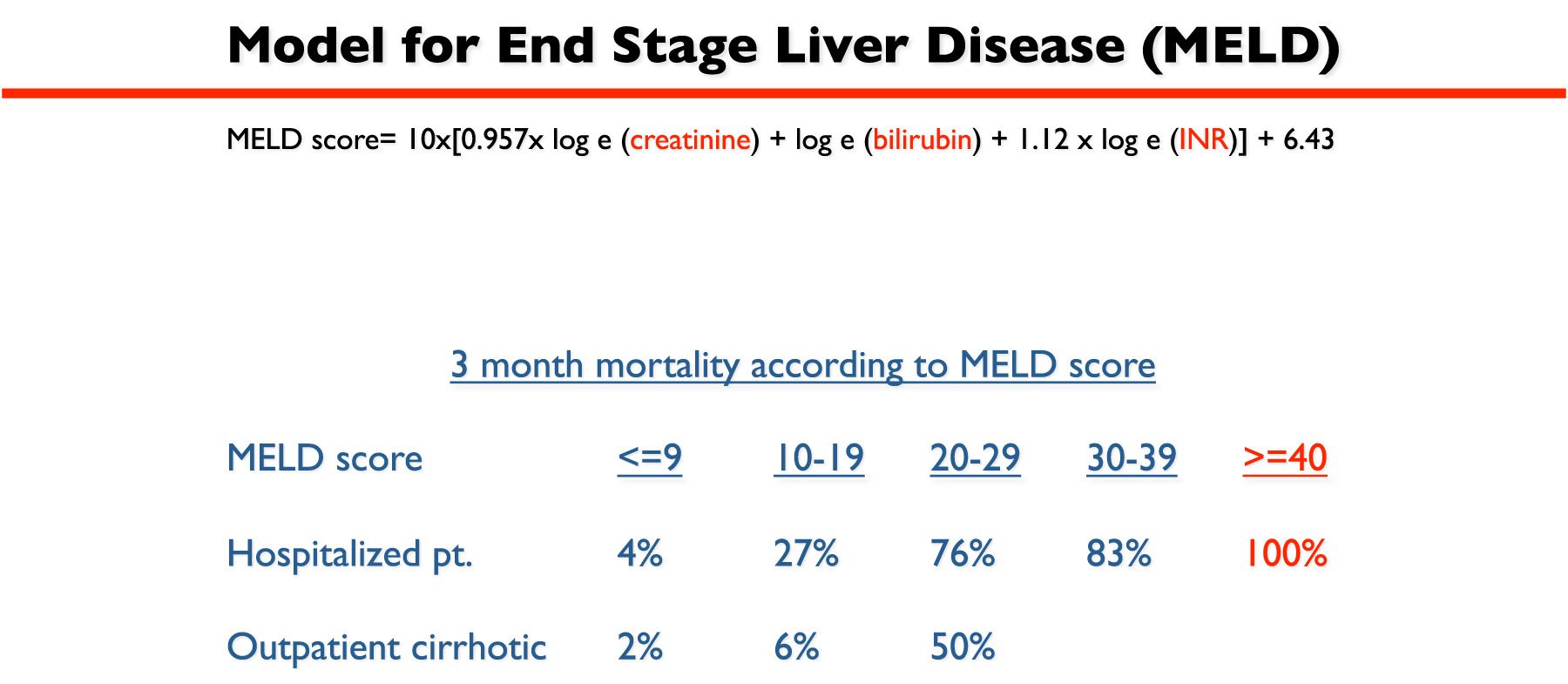

Patients with acute liver failure are given a distinction called "status 1," which supersedes MELD scores in terms of transplantation prioritization. Use of the MELD score to prioritize transplants has lead to a decreased rate of pretransplant death for those on the waiting list, but use of the score causes some controversy because it does not indicate survival benefit of transplantation. >15: may benefit from liver transplantationĬertain clinical situations lead to automatic increases in the MELD score in an attempt to increase or decrease waiting times on a liver transplant waiting list:.Scores are used to prioritize liver transplantation: These variables are used to calculate the score 2: MELD = (0.957 x ln ) + (0.378 x ln ) + (1.120 x ln ) + 0.643 if dialysis twice in last week, then creatinine is given a value of 4 mg/dl.The score has prognostic value in terms of three month mortality and certain complications. Evaluation and prognosis of patients with cirrhosis.The MELD score ( Model for End-stage Liver Disease) is a classification used to grade liver dysfunction in preparation for liver transplantation. You can learn more about how we ensure our content is accurate and current by reading our editorial policy. People who have a MELD score of 20 to 29 have a 19.6 to 45.5 risk of dying within the first three months. People who have a MELD score of 10 to 19 have a 6 to 20 risk of dying within the first three months. We link primary sources - including studies, scientific references, and statistics - within each article and also list them in the resources section at the bottom of our articles. People who have a MELD score of less than 9 have a 1.9 to 3.7 risk of dying within the first three months. Medical News Today has strict sourcing guidelines and draws only from peer-reviewed studies, academic research institutions, and medical journals and associations. avoiding taking vitamin C, if iron levels are high.Cirrhosis itself can affect diet and metabolism, so people should try: This means eating a healthful diet is crucial for those with this condition. Of people who develop cirrhosis, 20–60% also develop malnutrition, additional complications, longer hospital stays, and a reduced life expectancy. getting regular check-ups and prompt treatment for complications.getting treatment for conditions that might have caused cirrhosis, such as hepatitis C or B.


To prevent progressing from the asymptomatic to the symptomatic stage, people can make the following lifestyle changes: This is a challenging process, although one of the critical steps is avoiding alcohol of any kind. Healthcare professionals will project the life expectancy of people with cirrhosis using CTP scores in the following chart:Īccording to the VA, although cirrhosis is progressive, some people with the condition can move from decompensated, or symptomatic, back to the asymptomatic stage. Based on these scores, the system assigns people into different classes: With the CTP system, a person’s score increases according to the number and severity of their symptoms. normal blood clotting time, or international normalized ratio (INR).high levels of bilirubin, which could mean the liver is not working properly.normal levels of albumin, a protein made by the liver.an abnormal build-up of fluid in the abdomen, and how it responds to treatment.The Child-Turcotte-Pugh (CTP) system awards points based on whether an individual has: Physicians use diagnostic tests and scoring to determine a person’s stage of cirrhosis, which will help project their life expectancy. Their life expectancy is greatly reduced than those with compensated cirrhosis, while experts recommend referral for a possible liver transplant in these cases. A person can remain asymptomatic for years, although 5–7% of those with the condition will develop symptoms every year.ĭecompensated cirrhosis: People with decompensated cirrhosis already experience symptoms and complications. There are two stages in cirrhosis: compensated and decompensated.Ĭompensated cirrhosis: People with compensated cirrhosis do not show symptoms, while life expectancy is around 9–12 years.


 0 kommentar(er)
0 kommentar(er)
